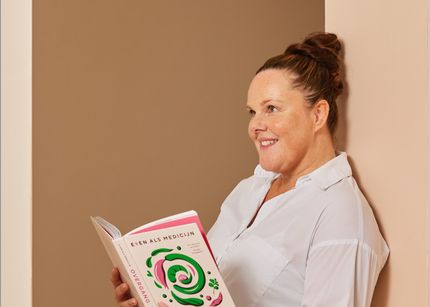Loss of muscle mass and menopause
As you get older, you gradually begin losing muscle mass. Loss of muscle mass and strength is a common and natural part of ageing. However, during menopause, hormone imbalances can also cause muscle loss. Has your muscle strength deteriorated recently? Do you have little energy? Small lifestyle adjustments and exercise can help keep your muscles strong and healthy for a long time to come.

Menopause has been rough. My energy level is low, I don’t sleep and my muscle strength has lessened, too. I hope exercises will help to get my strength back. - Sharon (age 47)

Research shows that postmenopausal women are overwhelmingly more likely to have sarcopenia (muscle loss) than perimenopausal women. The reason for this is that oestrogen continues to decline during perimenopause and menopause. When you reach postmenopause, your oestrogen and progesterone levels are consistently low. Therefore, it's virtually inevitable that your muscle mass and strength will decline.
Age is also a factor. We generally start to lose muscle mass in our thirties at a rate of around 3 to 8 percent per decade. After age 60, we lose muscle mass more quickly. All the more reason to take good care of your body. It's working hard for you behind the scenes.
What is happening in your body?
What symptoms you will get during menopause depends on many factors and can vary greatly from one person to the next. Common symptoms of menopause include hot flashes and mood swings. This new stage of life also comes with physical changes, such as loss of muscle mass and strength. This can result in muscle weakness and reduced overall fitness. Why does this happen?
Oestrogen is a hormone that is involved in many processes in the body. It also plays a key role in keeping your bones, joints and muscles healthy. When you lose oestrogen around menopause, you also lose muscle mass. It’s a condition called sarcopenia. One of the things you may have noticed is a reduction in muscle strength and energy. You may find that activities you used to do with ease, such as exercising, cycling or hiking, have become much more difficult.
Other muscle and joint problems
Low oestrogen in menopause can also cause other muscle or joint problems. You may notice that your muscles are achy (even without having exercised) or stiff or tense. You may notice that your movements are less fluid and that it takes much more effort to get up in the morning.
You may experience pain in your joints (often the small joints of the hands, wrists and fingers). You may develop osteoporosis, a condition that weakens bones and makes them brittle. Osteoporosis happens gradually over years – you don’t notice that your bones are getting thinner.
All this makes it even more important to protect the health of your bones, muscles and joints to prevent future problems. While symptoms are a normal part of menopause, you don't have to live with them. In fact, some simple modifications to your lifestyle and diet can keep your body strong and healthy for years to come.
What can you do?
Researchers agree that staying active is one of the most important things you can do for your muscle health. In addition, multiple studies have shown that having a protein-rich diet is imperative. The following tips can help reverse muscle problems and slow down muscle mass loss:
- Eat protein. When you eat protein, your body breaks the protein down into amino acids. Amino acids are building blocks for muscle growth. For optimal health, women should consume one gram of protein per kilogram of body weight. So if you weigh 80 kilos, you need to eat 80 grams of protein a day. Good sources of protein are seeds, kernels, nuts, peanuts (and peanut butter), tofu, tempeh, lentils, cheese, tuna, salmon and meat. For example, one handful of nuts contains five grams of protein, and a fried egg contains seven grams of protein. Want to know how much protein you are eating during the course of a day? There are apps that enable you track your protein intake.
- Stay physically active. Strength training (for the large muscle groups: chest, shoulders, legs, buttocks and back) and cardio exercises are good for your muscles. Strength training puts pressure on the bones, which helps build bone density. The added benefit is that exercise triggers dopamine release. Higher dopamine levels result in better overall mood. Our advice? Get at least 30 minutes of moderate physical activity a day (swimming, walking, jogging) and do strength training twice a week. This is especially important for menopausal women as they tend to be less active due to low energy and lack of sleep.
- Make sleep your number one priority. Sleep is essential for building muscle mass after exercising. Improve your sleep habits (sleep hygiene) and prioritise sleep.
Your path to a smooth menopause starts here
Get the tools you need to navigate menopause with more ease and to educate yourself about your body. With tips and insights from experts, and relatable stories of women just like you. Press play, not pause.
What treatments can help?
Do you feel physically weaker than before menopause? This is actually quite common. Even though it may be difficult, staying active is one of the most important things you can do to keep your muscles strong. In addition, research also shows that having a protein-rich diet is imperative for maintaining muscle mass.

Strength training and watching my protein intake have helped me tremendously. I can lift my grocery bags easily now. – Josie (age 58)

Can hormone therapy help?
Hormone replacement therapy (HRT) replaces the hormones a woman's body stops making due to menopause. HRT can be an effective way to treat severe symptoms, such as mood swings and hot flashes. Do you suffer from muscle loss as well as other severe menopausal symptoms? Then HRT might be an option for you.
Sources
- Roubenoff R. (2000). Sarcopenia: a major modifiable cause of frailty in the elderly. J Nutr Health Aging. PMID: 10936900.
- Dionne IJ, Kinaman KA, Poehlman ET. (2000). Sarcopenia and muscle function during menopause and hormone-replacement therapy. J Nutr Health Aging. PMID: 10936902.
- Douchi T, Yamamoto S, Nakamura S, Ijuin T, Oki T, Maruta K, Nagata Y. (1998). The effect of menopause on regional and total body lean mass. Maturitas. PMID: 9699196.
- Volpi E, Nazemi R, Fujita S. (2004). Muscle tissue changes with aging. Curr Opin Clin Nutr Metab Care. PMID: 15192443.
- Maltais ML, Desroches J, Dionne IJ. (2009). Changes in muscle mass and strength after menopause. J Musculoskelet Neuronal Interact. PMID: 19949277.
- R. J. Baber, N. Panay & A. Fenton the IMS Writing Group (2016). IMS Recommendations on women’s midlife health and menopause hormone therapy. https://www.imsociety.org/wp-content/uploads/2020/08/2016-ims-hrt-health-recommendations-english.pdf.
Tips and advice


FAQ
I suffer from painful joints, what can I do?
If the amount of oestrogen in your body fluctuates, you may notice it in your bones and joints. Most important? Keep moving, even if you are stiff or immobile. Moving less will only make the pain or stiffness worse. More on joint pain.












